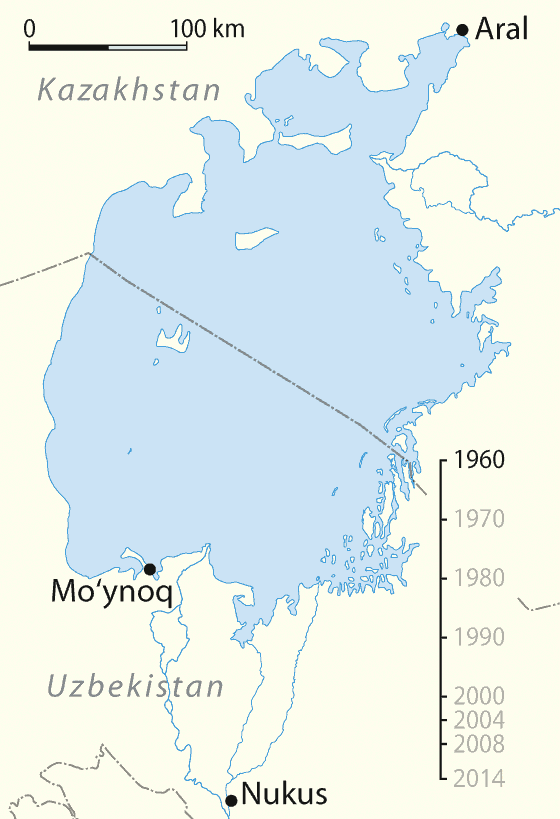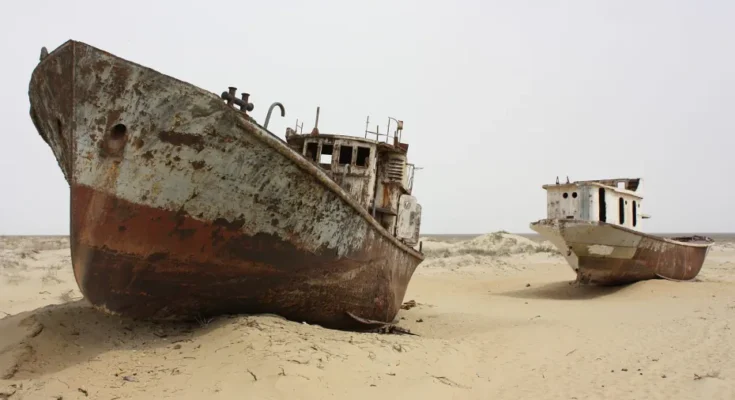Once a sprawling body of water and the fourth-largest lake in the world, the Aral Sea stood as a shimmering jewel in Central Asia. Situated between Kazakhstan and Uzbekistan, this vast lake once covered an area of approximately 68,000 square kilometers, making it the second-largest lake in Asia. However, the Aral Sea has undergone a dramatic transformation, shrinking by nearly 90% in recent decades due to human activities. Its tragic decline has turned it from a life-sustaining oasis into one of the world’s most haunting environmental disasters.

The Aral Sea was fed primarily by two rivers: the Syr Darya to the north and the Amu Darya to the south. These rivers carried water from distant mountains, replenishing the lake and supporting a vibrant ecosystem. Surrounding communities thrived on the Aral’s abundant fish, which sustained a prosperous fishing industry, while the lake moderated the region’s climate, fostering agricultural productivity.

Timeline of water levels in the Aral Sea Basin
However, in the mid-20th century, the Soviet Union launched an ambitious plan to increase cotton production in the arid lands of Central Asia. Large-scale irrigation projects were implemented to divert water from the Syr Darya and Amu Darya into vast networks of canals, which would nourish cotton fields and other crops. These projects were poorly planned and inefficient, with significant water losses due to evaporation and leakage. Over time, the rivers feeding the Aral Sea dwindled, and the lake began to shrink.
By the 1980s, the Aral Sea’s decline had become evident. Its once expansive surface area receded, splitting into smaller, isolated bodies of water. With the loss of freshwater inflow, salinity levels skyrocketed, rendering the remaining water inhospitable to most aquatic life. The thriving fishing industry collapsed, leaving communities along the shores economically devastated.
Today, the Aral Sea is referred to as the “Aral sand desert,” a barren wasteland where rusted ships lie abandoned on dry sands, a stark reminder of the lake’s former grandeur. These ghostly relics have become symbols of ecological ruin, attracting the attention of environmentalists, scientists, and photographers worldwide.

The environmental consequences of the Aral Sea’s disappearance are profound. The loss of water has altered the local climate, making summers hotter and winters colder. Dust storms carrying toxic salts and pesticides from the dried lakebed have become a health hazard for nearby populations, leading to respiratory illnesses and other health problems.
Despite the grim reality, efforts have been made to mitigate the damage. In Kazakhstan, the construction of the Kok-Aral Dam in 2005 has helped partially restore the northern part of the Aral Sea, known as the “Small Aral Sea.” The project has increased water levels and reduced salinity, allowing some fish species to return. However, the southern part, which lies in Uzbekistan, remains largely a desolate desert.
The story of the Aral Sea is a cautionary tale about the dangers of unsustainable resource management. It highlights the delicate balance between human activity and nature, reminding us of the devastating consequences when that balance is disrupted. The Aral’s legacy serves as a somber warning and a call to action for preserving our planet’s precious ecosystems.



